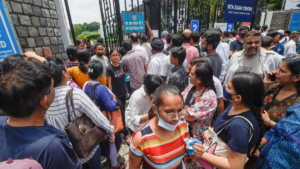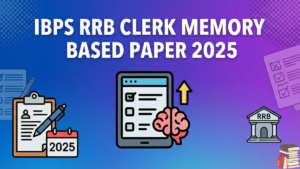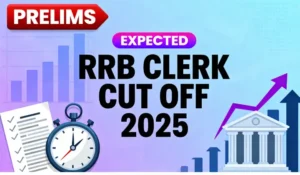Dear Aspirants,
Reasoning Ability is an onerous section. With the increasing complexity of questions, it becomes hard for one to give it a cold shoulder. The only way to make the grade in this particular section in the forthcoming SBI PO Prelims and other banking exams is to practice continuously with all your heart and soul. And, to let you practice with the best of latest pattern questions, here is the Adda247 Reasoning Quiz with the exact same pattern of questions that are being asked in the exams.
Directions (1-5): Study the information and answer the given questions:
Eight students A, B, C, D, E, F, G and H have their Sbi exam in the months of March, June, August and September but not necessarily in the same order. In each month, they have their exam on either 1st or 8th of the given month. Not more than two students will have their exam on the same month.
H will have exam on 1st of any given month which has 31 days. Only one student will have exam after F. Two students will have exam between F and B. Only one student has exam between B and C. A has exam immediately after G. D does not have his exam on the last day and doesn’t have exam in the month which has 30 days. G does not have his exam after D.
Q1. Who among following has his exam immediately after E?
(a) A
(b) C
(c) G
(d) No one.
(e) B
Q2. Who among following has exam on 1st June?
(a) A
(b) C
(c) G
(d)H
(e) B
Q3. D will have exam on which date and month?
(a) 8th March
(b) 1st March
(c) 1st June
(d) 1st August
(e) None of these
Q4. Who among following will have exam in the month of August?
(a) A, C
(b) C, B
(c) G, H
(d) D, C
(e) B, H
Q5. How many student(s) will have exam between D and C?
(a) One
(b) No one.
(c) five
(d) two
(e) Four
Direction (6-7): Read the information carefully and answer the questions:
Eight persons- A, B, C, D, E, F, G and H are sitting around a circle but not necessary in the same order. Some of them are facing toward the centre and some are facing outside the centre of the circle. Two persons sit between C and H and two persons sit between A and C. F sits second right to D. F faces outside the centre of the circle. Immediate neighbors of both A and B face opposite direction. C faces D.
E is not an immediate neighbour of B, who faces inside. B sits opposite to H, who faces inside the centre. B is not an immediate neighbour of F. Not more than two people who sit together (adjacent) face in the same direction.
Q6. Who among following sits second to the right of G?
(a) A
(b) B
(c) C
(d) D
(e) None of these
Q7. Who is sitting third to the left of C?
(a) A
(b) B
(c) C
(d) D
(e) None of these
Q8. Harsh walks 3m towards North then turns in west direction and walks 2m, then turns North again and walk 1m and then turns toward East and walk 5m. Now How far away he is from his starting point?
(a) 1 m
(b) 2 m
(c) 3 m
(d) 5 m
(e) 6m
Q9. Raj is to the West of Rohit. Raj is to the south of Rajesh. Harsh is to the East of Raj. Harsh is towards which direction of Rohit?
(a) South
(b) East
(c) North-East
(d) Cannot determined
(e) None of these
Q10. A walks 20 m towards North then takes a left turn and walks 10 m, then takes a right turn and walks 20 m and then again takes a right turn and walks 10 m. Now How far he is from his starting point?
(a) 50 m
(b) 60 m
(c) 40 m
(d) Cannot be determined
(e) None of these
Directions (11-15): In these questions, a relationship between different elements is shown in the statements. The statements are followed by two conclusions. Give answer
Q11. Statement: P>Q; G=D≤E; G≥F<Q
Conclusion: I. G≥P II. E>G
(a) if only conclusion II is true.
(b) if only conclusion I is true.
(c) if neither conclusion I nor II is true.
(d) if either conclusion I or II is true.
(e) if both conclusions I and II are true.
Q12. Statement: M>S≥K; A>S=H; M>T
Conclusion: I. A>T II. A≤T
(a) if both conclusion I and II are true.
(b) if only conclusion I is true.
(c) if neither conclusion I nor II is true.
(d) if either conclusion I or II is true.
(e) if only conclusion II is true.
Q13. Statement: A>K; Q<O>M≥N; K≥O=T
Conclusion: I. K≥N II. A>T
(a) if only conclusion II is true.
(b) if either conclusion I or II is true.
(c) if neither conclusion I nor II is true.
(d) if only conclusion I is true.
(e) if both conclusions I and II are true.
Q14. Statement: J> T≤N; A>T>R; N<M
Conclusion: I. M> J II. J≤M
(a) if only conclusion II is true.
(b) if only conclusion I is true.
(c) if neither conclusion I nor II is true.
(d) if either conclusion I or II is true.
(e) if both conclusions I and II are true.
Q15. Statement: D>B≥C; F<M≤T<D; B>Q
Conclusion: I. C<F II. D>Q
(a) if only conclusion II is true.
(b) if either conclusion I or II is true.
(c) if neither conclusion I nor II is true.
(d) if only conclusion I is true.
(e) if both conclusions I and II are true.






 IBPS RRB Clerk Prelims Exam Analysis 202...
IBPS RRB Clerk Prelims Exam Analysis 202...
 IBPS RRB Clerk Memory Based Paper 2025, ...
IBPS RRB Clerk Memory Based Paper 2025, ...
 IBPS RRB Clerk Expected Cut off 2025, Ch...
IBPS RRB Clerk Expected Cut off 2025, Ch...








